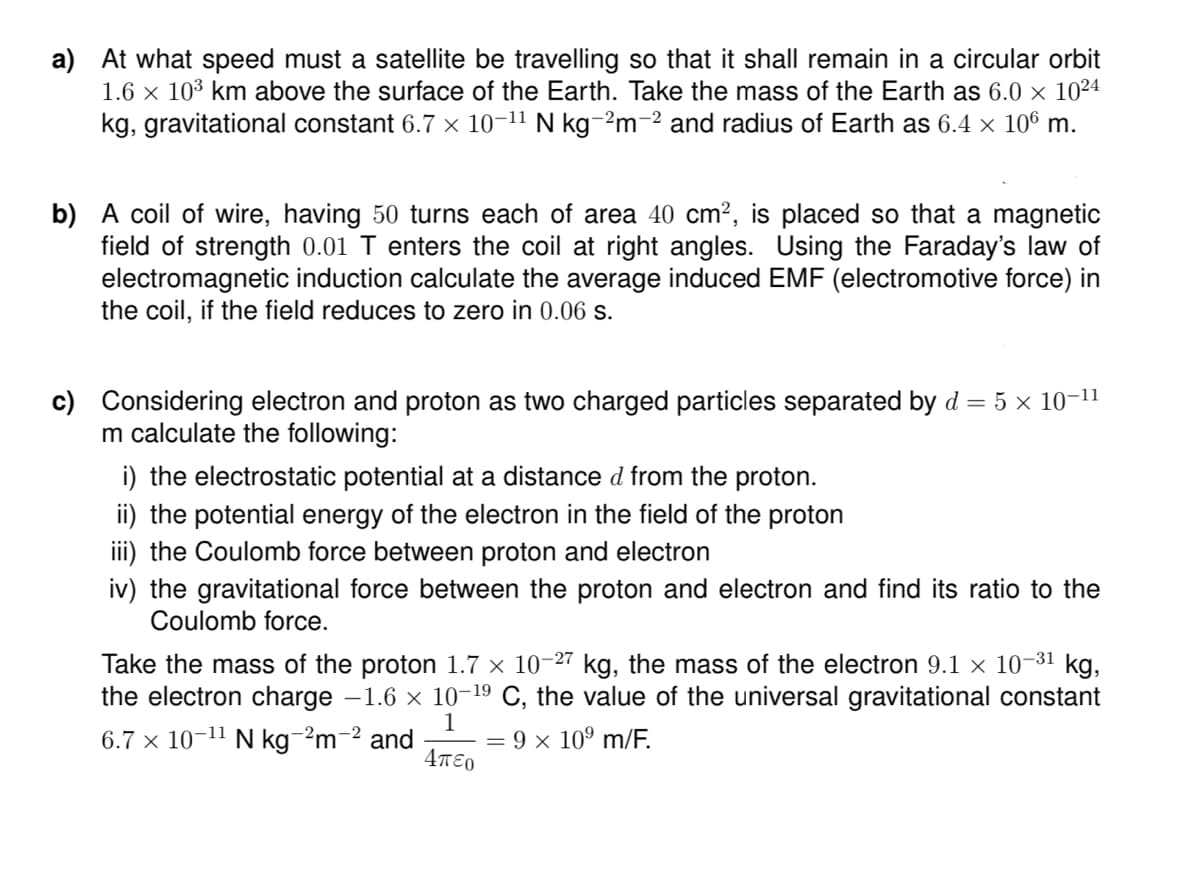At what speed must a satellite be travelling so that it shall remain in a circular orbit 1.6 x 103 km above the surface of the Earth. Take the mass of the Earth as 6.0 × 1024 kg, gravitational constant 6.7 × 10-11 N kg-²m-2 and radius of Earth as 6.4 × 106 m.
At what speed must a satellite be travelling so that it shall remain in a circular orbit 1.6 x 103 km above the surface of the Earth. Take the mass of the Earth as 6.0 × 1024 kg, gravitational constant 6.7 × 10-11 N kg-²m-2 and radius of Earth as 6.4 × 106 m.
Elements Of Electromagnetics
7th Edition
ISBN:9780190698614
Author:Sadiku, Matthew N. O.
Publisher:Sadiku, Matthew N. O.
ChapterMA: Math Assessment
Section: Chapter Questions
Problem 1.1MA
Related questions
Question

Transcribed Image Text:a) At what speed must a satellite be travelling so that it shall remain in a circular orbit
1.6 x 103 km above the surface of the Earth. Take the mass of the Earth as 6.0 × 10²4
kg, gravitational constant 6.7 × 10-11 N kg-2m-2 and radius of Earth as 6.4 × 106 m.
b) A coil of wire, having 50 turns each of area 40 cm?, is placed so that a magnetic
field of strength 0.01 T enters the coil at right angles. Using the Faraday's law of
electromagnetic induction calculate the average induced EMF (electromotive force) in
the coil, if the field reduces to zero in 0.06 s.
c) Considering electron and proton as two charged particles separated by d = 5 × 10-11
m calculate the following:
i) the electrostatic potential at a distance d from the proton.
ii) the potential energy of the electron in the field of the proton
iii) the Coulomb force between proton and electron
iv) the gravitational force between the proton and electron and find its ratio to the
Coulomb force.
Take the mass of the proton 1.7 × 10-27 kg, the mass of the electron 9.1 × 10-31 kg,
the electron charge -1.6 x 10-19 C, the value of the universal gravitational constant
1
6.7 × 10-11 N kg-2m-2 and
4πεο
9 × 10° m/F.
Expert Solution
This question has been solved!
Explore an expertly crafted, step-by-step solution for a thorough understanding of key concepts.
Step by step
Solved in 3 steps with 3 images

Knowledge Booster
Learn more about
Need a deep-dive on the concept behind this application? Look no further. Learn more about this topic, mechanical-engineering and related others by exploring similar questions and additional content below.Recommended textbooks for you

Elements Of Electromagnetics
Mechanical Engineering
ISBN:
9780190698614
Author:
Sadiku, Matthew N. O.
Publisher:
Oxford University Press

Mechanics of Materials (10th Edition)
Mechanical Engineering
ISBN:
9780134319650
Author:
Russell C. Hibbeler
Publisher:
PEARSON

Thermodynamics: An Engineering Approach
Mechanical Engineering
ISBN:
9781259822674
Author:
Yunus A. Cengel Dr., Michael A. Boles
Publisher:
McGraw-Hill Education

Elements Of Electromagnetics
Mechanical Engineering
ISBN:
9780190698614
Author:
Sadiku, Matthew N. O.
Publisher:
Oxford University Press

Mechanics of Materials (10th Edition)
Mechanical Engineering
ISBN:
9780134319650
Author:
Russell C. Hibbeler
Publisher:
PEARSON

Thermodynamics: An Engineering Approach
Mechanical Engineering
ISBN:
9781259822674
Author:
Yunus A. Cengel Dr., Michael A. Boles
Publisher:
McGraw-Hill Education

Control Systems Engineering
Mechanical Engineering
ISBN:
9781118170519
Author:
Norman S. Nise
Publisher:
WILEY

Mechanics of Materials (MindTap Course List)
Mechanical Engineering
ISBN:
9781337093347
Author:
Barry J. Goodno, James M. Gere
Publisher:
Cengage Learning

Engineering Mechanics: Statics
Mechanical Engineering
ISBN:
9781118807330
Author:
James L. Meriam, L. G. Kraige, J. N. Bolton
Publisher:
WILEY